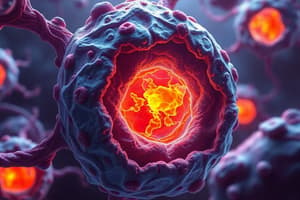Podcast
Questions and Answers
What is hypertrophy?
What is hypertrophy?
- Decrease in cell size
- Increase in cell numbers
- Increase in cell and organ size (correct)
- Change in phenotype of differentiated cells
What causes hyperplasia?
What causes hyperplasia?
- Decreased nutrient supply
- Damage to cellular components
- Change in cell phenotype
- Increased cell numbers in response to hormones (correct)
Atrophy is an increase in cell size and organ size.
Atrophy is an increase in cell size and organ size.
False (B)
Metaplasia involves a change in phenotype of differentiated cells.
Metaplasia involves a change in phenotype of differentiated cells.
What is hypoxia?
What is hypoxia?
Which of the following can cause cell injury?
Which of the following can cause cell injury?
What is the role of mitochondria in cell death?
What is the role of mitochondria in cell death?
What can trigger apoptosis?
What can trigger apoptosis?
Flashcards are hidden until you start studying
Study Notes
Cellular Adaptations to Stress
- Hypertrophy: Increase in cell and organ size due to elevated workload; common in tissues unable to divide; triggered by growth factors from mechanical stress.
- Hyperplasia: Increase in cell number induced by hormones and growth factors; occurs in tissues capable of cell division and those with abundant stem cells.
- Atrophy: Decrease in cell and organ size caused by reduced nutrient supply or disuse; linked to diminished synthesis and enhanced breakdown of cellular components.
- Metaplasia: Alteration in the phenotype of differentiated cells due to chronic irritation; results from changes in tissue stem cell differentiation; may lead to reduced functionality or higher cancer risk.
Causes of Cell Injury
- Oxygen Deprivation: Hypoxia, a lack of oxygen, impairs aerobic respiration, leading to cell injury.
- Physical Agents: Mechanical trauma, extreme temperatures, sudden atmospheric pressure changes, radiation, and electric shock contribute to cell injury.
- Chemical Agents and Drugs: Hypertonic concentrations of simple chemicals (e.g., glucose, salt) can disrupt electrolyte balance; high oxygen levels can be toxic.
- Infectious Agents: Range from viruses to tapeworms; includes bacteria, fungi, and parasites; immune responses may also cause cell injury.
- Immunologic Reactions: Reactions to self antigens can result in autoimmune diseases, contributing to cell damage.
- Genetic Defects: Enzyme defects and DNA damage from misfolded proteins lead to cell death when repair mechanisms fail.
- Nutritional Imbalances: Protein-calorie deficiencies are significant causes of cell injury, especially in underprivileged populations.
Mechanisms of Cell Injury
- ATP Depletion: Results in loss of energy-dependent functions, leading to reversible injury followed by necrosis.
- Mitochondrial Damage: Causes ATP depletion and failure of cellular functions; leakage of proteins can induce apoptosis.
- Calcium Influx: Activates destructive enzymes and can promote apoptosis.
- Reactive Oxygen Species Accumulation: Leads to covalent modifications of proteins, lipids, and nucleic acids, damaging the cell.
- Increased Membrane Permeability: Affects various cellular membranes; often leads to necrosis.
- Damaged DNA and Misfolded Proteins: Triggers apoptosis due to irreparable cellular damage.
Cell Death (Role of Mitochondria)
- Mitochondria play a critical role in balancing cell survival and death by providing ATP and metabolites.
- Necrosis: Resulting from external injury, it disrupts mitochondrial function via permeability transition pores, leading to cell death.
- Apoptosis: Programmed cell death essential for normal tissue development, can be activated by extrinsic signals such as cytotoxic T cells.
Studying That Suits You
Use AI to generate personalized quizzes and flashcards to suit your learning preferences.




